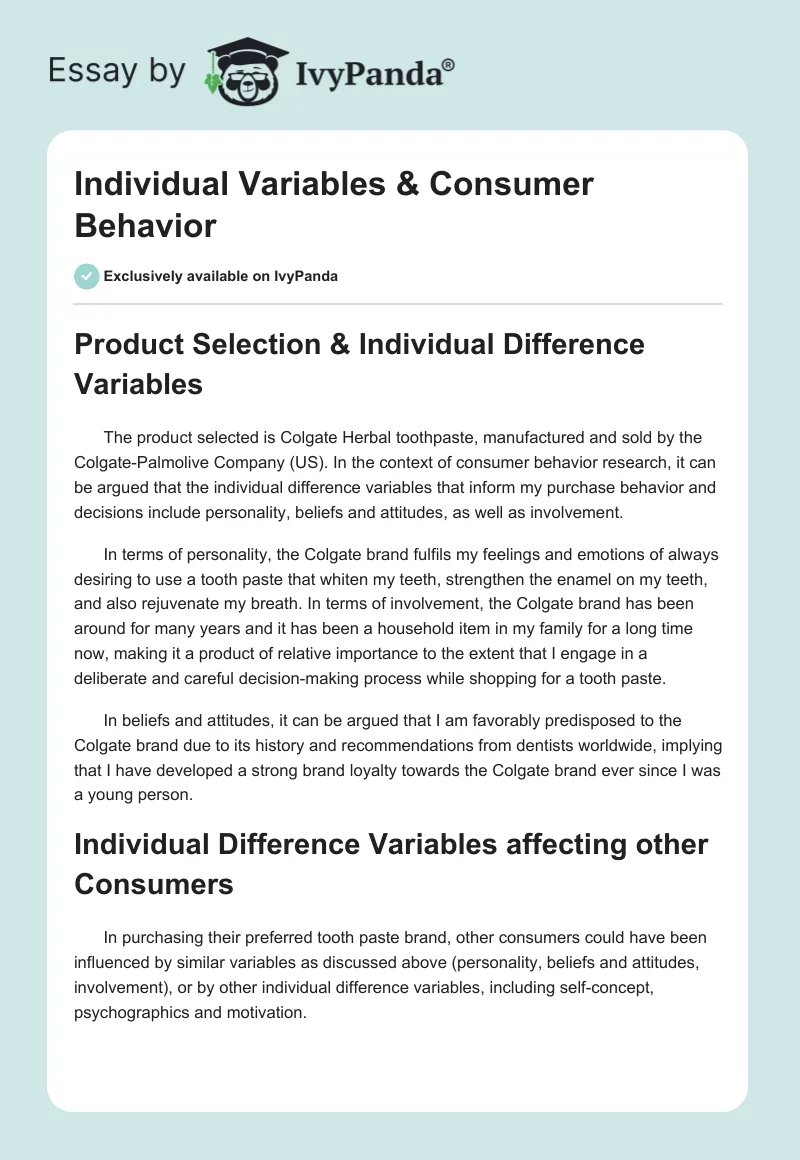Product Selection & Individual Difference Variables
The product selected is Colgate Herbal toothpaste, manufactured and sold by the Colgate-Palmolive Company (US). In the context of consumer behavior research, it can be argued that the individual difference variables that inform my purchase behavior and decisions include personality, beliefs and attitudes, as well as involvement.
In terms of personality, the Colgate brand fulfils my feelings and emotions of always desiring to use a tooth paste that whiten my teeth, strengthen the enamel on my teeth, and also rejuvenate my breath. In terms of involvement, the Colgate brand has been around for many years and it has been a household item in my family for a long time now, making it a product of relative importance to the extent that I engage in a deliberate and careful decision-making process while shopping for a tooth paste.
In beliefs and attitudes, it can be argued that I am favorably predisposed to the Colgate brand due to its history and recommendations from dentists worldwide, implying that I have developed a strong brand loyalty towards the Colgate brand ever since I was a young person.
Individual Difference Variables affecting other Consumers
In purchasing their preferred tooth paste brand, other consumers could have been influenced by similar variables as discussed above (personality, beliefs and attitudes, involvement), or by other individual difference variables, including self-concept, psychographics and motivation.
In personality, while some consumers may desist from buying the Colgate brand since it’s from an American company, others may indeed develop strong emotions, thoughts and feelings of the product based on the fact that it has been in the market for as long as they could remember. In self-concept and psychographics, consumers may favor the Colgate brand due to their own thoughts, feelings and opinions about the efficacy of Colgate in maintaining healthy teeth and gum when compared to other tooth pastes in the market.
Moving on to involvement, it is true that other consumers may develop a low or high relative importance towards the Colgate brand based on a number of factors such as quality, price, and availability. The level of relative importance ultimately determines their deliberations and purchasing decisions.
In motivation, marketing literature demonstrates that consumers may be motivated to buy the Colgate brand due to internal stimuli search as personal convictions or due to external stimuli such as reinforcement from friends and family members. Lastly, in beliefs and attitudes, consumers may be predisposed to positively or negatively react to a wide variety of stimuli (e.g., price and quality considerations) in making their purchase decisions.
Individual Differences & Formation of Market Segments
For marketers, a good understanding of the factors that shape and determine individual differences in consumer behavior serves as an important breakthrough not only in the formation of market segments, but also in the development of an effective marketing strategy.
Although key debates in the marketing literature often highlight a perceived concern that individual difference variables are becoming increasingly fragmented, scholars and practitioners are always relying on marketing research to come up with data aimed at grouping consumers who share the same variables into segments that are large enough to be targeted.
Information regarding individual differences can be used to know what group of consumers may be interested in what you have to offer, what group of consumers demonstrate similar individual variables to the extent that the same product or service will appeal to all of them, amount of money or level of interest these customers are prepared to spend or exhibit towards a product, and also what group of consumers may have similar attitudes and beliefs about the association between price and quality of the product for their own consumption experiences.
Marketers can then use this information to break down all consumers into categories of potential buyers of the product or service based on their shared profiles or shared individual difference variables, hence achieving market segmentation.
Ability to Develop a Marketing Strategy
Lastly, it can be argued that understanding the motivating behavior of market segments is fundamental in the process of enhancing the marketer’s capacity to develop an effective marketing strategy.
Indeed, understanding the motivating behavior behind the formation of any market segment not only assists marketers to understand the needs, demands, attitudes, values and beliefs of consumers toward a particular product or service, but also what could be done to the product or service (e.g., price or quality changes) to make it more appealing to the targeted segment.
Additionally, it is important for marketers to understand the motivating behavior of various market segments as this knowledge will assist them in developing strategies that could be included in the marketing plan to ensure the product or service continues to gain a foothold in the targeted market niche.
For example, an understanding of the motivating behavior of various segments will assist marketers in not only identifying the key strengths, weaknesses, opportunities and threats that a product or service may face in the market based on consumer individual differences, but also in coming up with proactive solutions geared toward eliciting more product or service appeal from potential consumers.
The resultant information and/or data can be included in a winning marketing strategy, which could then be used to target a particular segment consisting of consumers with similar profiles in customer behavior.


